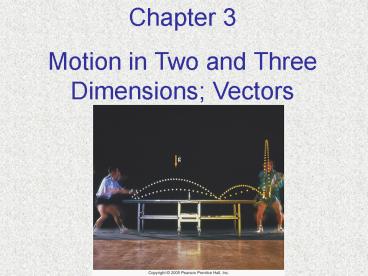Motion in Two and Three Dimensions; Vectors - PowerPoint PPT Presentation
1 / 25
Title:
Motion in Two and Three Dimensions; Vectors
Description:
Chapter 3 Motion in Two and Three Dimensions; Vectors Vectors and Scalars A vector has magnitude as well as direction. Some vector quantities: displacement, velocity ... – PowerPoint PPT presentation
Number of Views:226
Avg rating:3.0/5.0
Title: Motion in Two and Three Dimensions; Vectors
1
Chapter 3 Motion in Two and Three Dimensions
Vectors
2
Vectors and Scalars
A vector has magnitude as well as direction.
Some vector quantities displacement, velocity,
force, momentum
A scalar has only a magnitude. Some scalar
quantities mass, time, temperature
3
Addition of Vectors Graphical Methods
Adding the 2 vectors
Subtracting 2 vectors
4
Addition of Vectors Graphical Methods
Consider a motion in two dimensions. Suppose, you
move to the right 8.0 km and then 4.0 km up.
What is your displacement?
5
Adding Vectors by Components
Any vector can be expressed as the sum of two
other vectors, which are called its components.
Usually the other vectors are chosen so that they
are perpendicular to each other.
6
Adding Vectors by Components
7
Adding Vectors by Components
- Adding vectors
- Draw a diagram
- Choose x and y axes.
- Resolve each vector into x and y components.
- Calculate each component using sines and
cosines. - Add the components in each direction.
- To find the length and direction of the vector,
use
8
Adding Vectors by Components
9
Vector V1 is 6.6 units long and points along the
negative x axis. Vector V2 is 8.5 units long and
points at an angle of 45o to the positive x
axis. (a) What are the x and y components of each
vector? (b) Determine the sum (magnitude and
angle).
10
Unit vectors i and j
Express each vector as the sum of 2 perpendicular
vectors. It is common to use the horizontal and
vertical directions using unit vectors i and j
Example A Ax Ay Axi Ayj , where Ax and
Ay are the horizontal and vertical components B
Bx By Bxi Byj, where Bx and By are the
horizontal and vertical components
Some useful properties of unit vectors i.j0
i.i1 j.j1
A.B AxBxAyBy
11
Three vectors are expressed as A 4i j, B
-3i 2j, and C -3j. If R A B C, find
the magnitude and direction of R.
R A B C i-2j
magnitude 2.24 angle 63.4 o, below the
x-axis
12
Projectile Motion
A projectile is an object moving in two
dimensions under the influence of Earth's
gravity its path is a parabola.
13
Projectile Motion
This photograph shows two balls that start to
fall at the same time. The one on the right has
an initial speed in the x-direction. It can be
seen that vertical positions of the two balls are
identical at identical times, while the
horizontal position of the yellow ball increases
linearly.
14
Projectile Motion
A projectile can be understood by analyzing the
horizontal and vertical motions separately.
The speed in the x-direction is constant
in the y-direction the object moves with constant
acceleration g.
15
Projectile Motion
If an object is launched at an initial angle of
?0 with the horizontal, the analysis is similar
except that the initial velocity has a vertical
component.
16
Solving Problems Involving Projectile Motion
Projectile motion is motion with constant
acceleration in two dimensions, where the
acceleration is g and is down.
17
A diver running 1.8 m/s dives out horizontally
from the edge of a vertical cliff and 3.0 s later
reaches the water below. How high was the cliff,
and how far from its base did the diver hit the
water?
18
A football is kicked at ground level with a speed
of 18.0 m/s at an angle of 35.0º to the
horizontal. How much long later does it hit the
ground?
19
Extra Slides
20
(No Transcript)
21
Addition of Vectors Graphical Methods
Even if the vectors are not at right angles, they
can be added graphically by using the
tail-to-tip method.
22
Addition of Vectors Graphical Methods
The parallelogram method may also be used
23
Subtraction of Vectors, and Multiplication of a
Vector by a Scalar
In order to subtract vectors, we define the
negative of a vector, which has the same
magnitude but points in the opposite direction.
24
Subtraction of Vectors, and Multiplication of a
Vector by a Scalar
A vector V can be multiplied by a scalar c the
result is a vector cV that has the same direction
but a magnitude cV. If c is negative, the
resultant vector points in the opposite direction.
25
Addition of Vectors Graphical Methods
Adding the vectors in the opposite order gives
the same result































